CIPD 5UIN Assignment: Business Report on Leadership and Development
VerifiedAdded on 2022/11/18
|16
|4597
|254
Report
AI Summary
This report, submitted as part of the CIPD 5UIN module, focuses on leadership and development within the context of Human Resource Management. The report begins with an executive summary outlining the research's scope, methods, findings, and recommendations. It then delves into an introduction that identifies leadership and development as a critical area of HR practice, exploring its impact on organizational performance and employee engagement, referencing key concepts from Armstrong and Taylor (2014) and others. The main body of the report examines the research process, including stages of research, data collection methods, and a critical review of secondary research sources relevant to leadership development. The report emphasizes the importance of management training, succession planning, and quality performance management systems. The report concludes with justified recommendations for sustaining and/or improving practice, including suggestions for management training, mandatory training, and the adoption of quality performance management systems. The report adheres to the required structure, including a title page, executive summary, table of contents, introduction, main body, conclusions, recommendations, and a reference list. The report aims to provide a business-focused analysis of leadership and development practices, offering insights and recommendations for improvement. The report also includes a comparison of different data collection methods and summarizes the key stages of the research process.
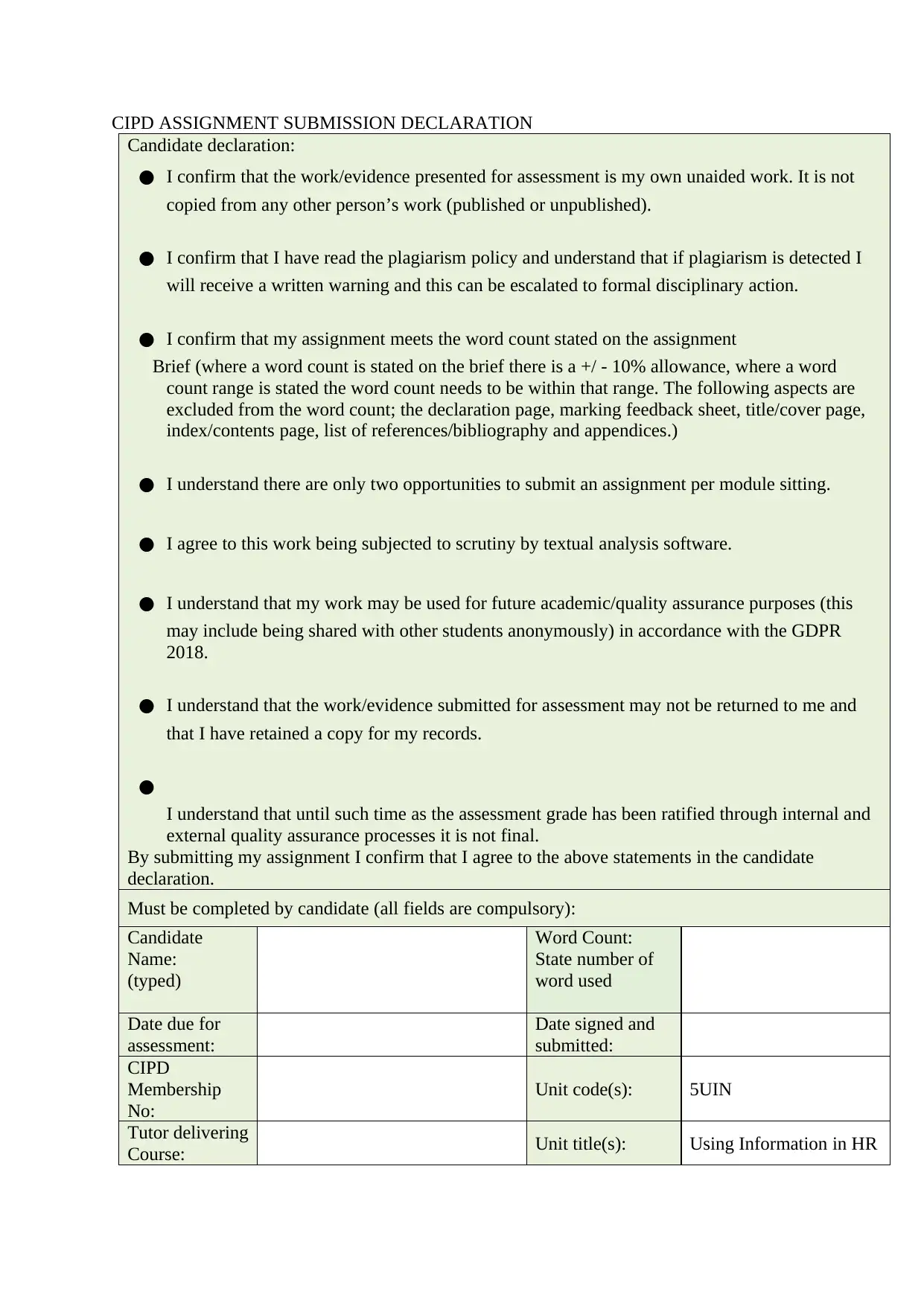
CIPD ASSIGNMENT SUBMISSION DECLARATION
Candidate declaration:
● I confirm that the work/evidence presented for assessment is my own unaided work. It is not
copied from any other person’s work (published or unpublished).
● I confirm that I have read the plagiarism policy and understand that if plagiarism is detected I
will receive a written warning and this can be escalated to formal disciplinary action.
● I confirm that my assignment meets the word count stated on the assignment
Brief (where a word count is stated on the brief there is a +/ - 10% allowance, where a word
count range is stated the word count needs to be within that range. The following aspects are
excluded from the word count; the declaration page, marking feedback sheet, title/cover page,
index/contents page, list of references/bibliography and appendices.)
● I understand there are only two opportunities to submit an assignment per module sitting.
● I agree to this work being subjected to scrutiny by textual analysis software.
● I understand that my work may be used for future academic/quality assurance purposes (this
may include being shared with other students anonymously) in accordance with the GDPR
2018.
● I understand that the work/evidence submitted for assessment may not be returned to me and
that I have retained a copy for my records.
●
I understand that until such time as the assessment grade has been ratified through internal and
external quality assurance processes it is not final.
By submitting my assignment I confirm that I agree to the above statements in the candidate
declaration.
Must be completed by candidate (all fields are compulsory):
Candidate
Name:
(typed)
Word Count:
State number of
word used
Date due for
assessment:
Date signed and
submitted:
CIPD
Membership
No:
Unit code(s): 5UIN
Tutor delivering
Course: Unit title(s): Using Information in HR
Candidate declaration:
● I confirm that the work/evidence presented for assessment is my own unaided work. It is not
copied from any other person’s work (published or unpublished).
● I confirm that I have read the plagiarism policy and understand that if plagiarism is detected I
will receive a written warning and this can be escalated to formal disciplinary action.
● I confirm that my assignment meets the word count stated on the assignment
Brief (where a word count is stated on the brief there is a +/ - 10% allowance, where a word
count range is stated the word count needs to be within that range. The following aspects are
excluded from the word count; the declaration page, marking feedback sheet, title/cover page,
index/contents page, list of references/bibliography and appendices.)
● I understand there are only two opportunities to submit an assignment per module sitting.
● I agree to this work being subjected to scrutiny by textual analysis software.
● I understand that my work may be used for future academic/quality assurance purposes (this
may include being shared with other students anonymously) in accordance with the GDPR
2018.
● I understand that the work/evidence submitted for assessment may not be returned to me and
that I have retained a copy for my records.
●
I understand that until such time as the assessment grade has been ratified through internal and
external quality assurance processes it is not final.
By submitting my assignment I confirm that I agree to the above statements in the candidate
declaration.
Must be completed by candidate (all fields are compulsory):
Candidate
Name:
(typed)
Word Count:
State number of
word used
Date due for
assessment:
Date signed and
submitted:
CIPD
Membership
No:
Unit code(s): 5UIN
Tutor delivering
Course: Unit title(s): Using Information in HR
Paraphrase This Document
Need a fresh take? Get an instant paraphrase of this document with our AI Paraphraser
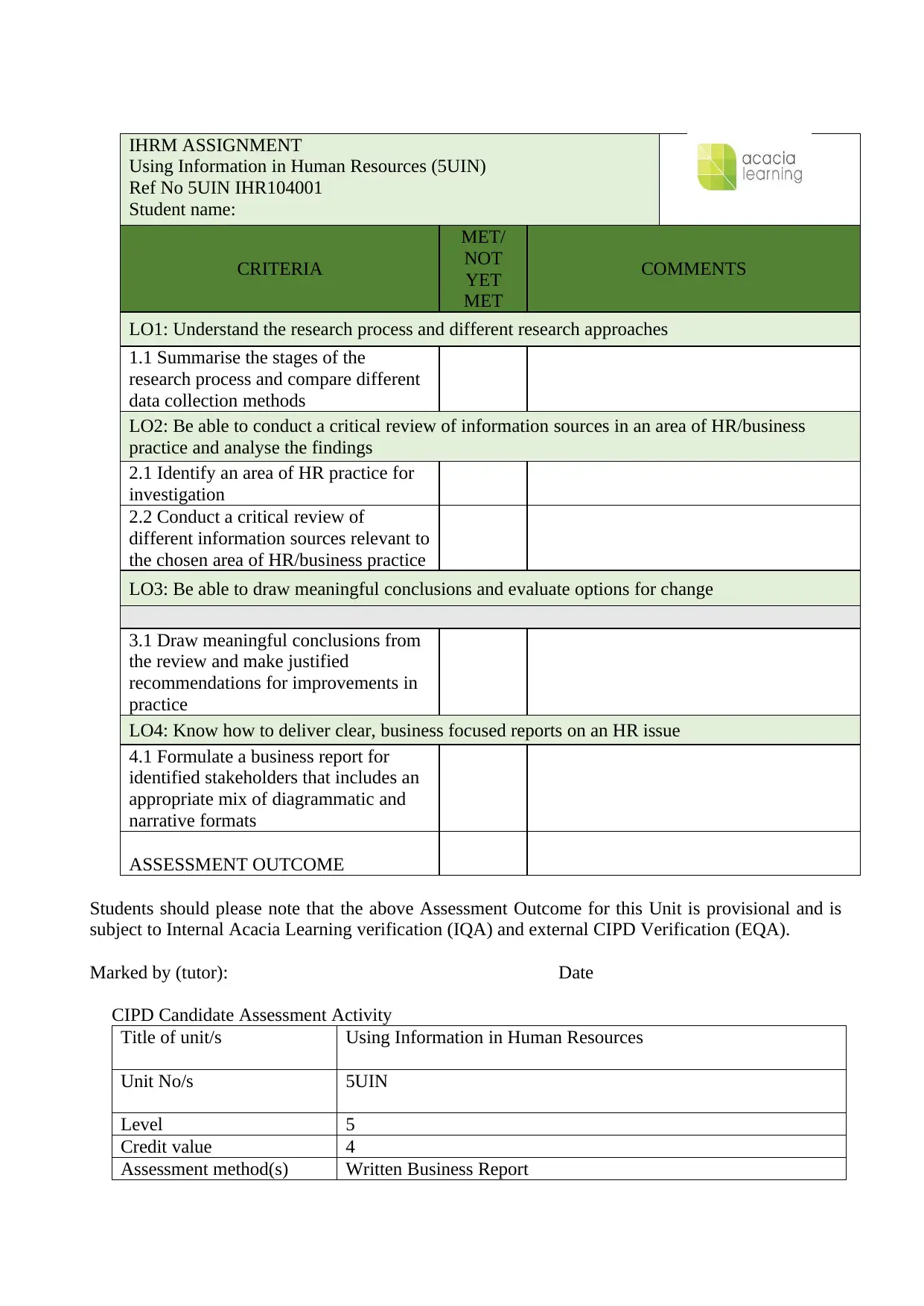
IHRM ASSIGNMENT
Using Information in Human Resources (5UIN)
Ref No 5UIN IHR104001
Student name:
CRITERIA
MET/
NOT
YET
MET
COMMENTS
LO1: Understand the research process and different research approaches
1.1 Summarise the stages of the
research process and compare different
data collection methods
LO2: Be able to conduct a critical review of information sources in an area of HR/business
practice and analyse the findings
2.1 Identify an area of HR practice for
investigation
2.2 Conduct a critical review of
different information sources relevant to
the chosen area of HR/business practice
LO3: Be able to draw meaningful conclusions and evaluate options for change
3.1 Draw meaningful conclusions from
the review and make justified
recommendations for improvements in
practice
LO4: Know how to deliver clear, business focused reports on an HR issue
4.1 Formulate a business report for
identified stakeholders that includes an
appropriate mix of diagrammatic and
narrative formats
ASSESSMENT OUTCOME
Students should please note that the above Assessment Outcome for this Unit is provisional and is
subject to Internal Acacia Learning verification (IQA) and external CIPD Verification (EQA).
Marked by (tutor): Date
CIPD Candidate Assessment Activity
Title of unit/s Using Information in Human Resources
Unit No/s 5UIN
Level 5
Credit value 4
Assessment method(s) Written Business Report
Using Information in Human Resources (5UIN)
Ref No 5UIN IHR104001
Student name:
CRITERIA
MET/
NOT
YET
MET
COMMENTS
LO1: Understand the research process and different research approaches
1.1 Summarise the stages of the
research process and compare different
data collection methods
LO2: Be able to conduct a critical review of information sources in an area of HR/business
practice and analyse the findings
2.1 Identify an area of HR practice for
investigation
2.2 Conduct a critical review of
different information sources relevant to
the chosen area of HR/business practice
LO3: Be able to draw meaningful conclusions and evaluate options for change
3.1 Draw meaningful conclusions from
the review and make justified
recommendations for improvements in
practice
LO4: Know how to deliver clear, business focused reports on an HR issue
4.1 Formulate a business report for
identified stakeholders that includes an
appropriate mix of diagrammatic and
narrative formats
ASSESSMENT OUTCOME
Students should please note that the above Assessment Outcome for this Unit is provisional and is
subject to Internal Acacia Learning verification (IQA) and external CIPD Verification (EQA).
Marked by (tutor): Date
CIPD Candidate Assessment Activity
Title of unit/s Using Information in Human Resources
Unit No/s 5UIN
Level 5
Credit value 4
Assessment method(s) Written Business Report
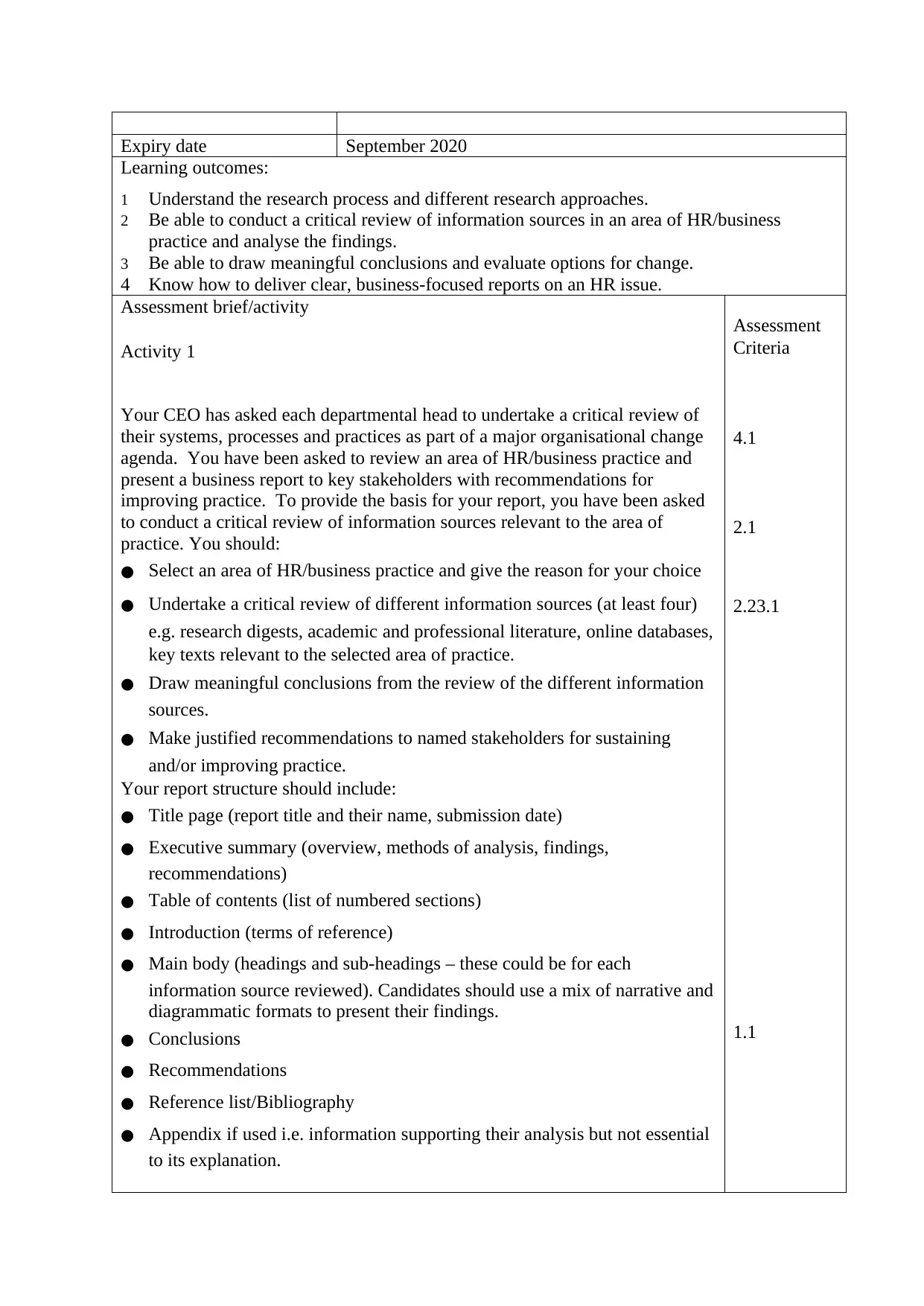
Expiry date September 2020
Learning outcomes:
1 Understand the research process and different research approaches.
2 Be able to conduct a critical review of information sources in an area of HR/business
practice and analyse the findings.
3 Be able to draw meaningful conclusions and evaluate options for change.
4 Know how to deliver clear, business-focused reports on an HR issue.
Assessment brief/activity
Activity 1
Your CEO has asked each departmental head to undertake a critical review of
their systems, processes and practices as part of a major organisational change
agenda. You have been asked to review an area of HR/business practice and
present a business report to key stakeholders with recommendations for
improving practice. To provide the basis for your report, you have been asked
to conduct a critical review of information sources relevant to the area of
practice. You should:
● Select an area of HR/business practice and give the reason for your choice
● Undertake a critical review of different information sources (at least four)
e.g. research digests, academic and professional literature, online databases,
key texts relevant to the selected area of practice.
● Draw meaningful conclusions from the review of the different information
sources.
● Make justified recommendations to named stakeholders for sustaining
and/or improving practice.
Your report structure should include:
● Title page (report title and their name, submission date)
● Executive summary (overview, methods of analysis, findings,
recommendations)
● Table of contents (list of numbered sections)
● Introduction (terms of reference)
● Main body (headings and sub-headings – these could be for each
information source reviewed). Candidates should use a mix of narrative and
diagrammatic formats to present their findings.
● Conclusions
● Recommendations
● Reference list/Bibliography
● Appendix if used i.e. information supporting their analysis but not essential
to its explanation.
Assessment
Criteria
4.1
2.1
2.23.1
1.1
Learning outcomes:
1 Understand the research process and different research approaches.
2 Be able to conduct a critical review of information sources in an area of HR/business
practice and analyse the findings.
3 Be able to draw meaningful conclusions and evaluate options for change.
4 Know how to deliver clear, business-focused reports on an HR issue.
Assessment brief/activity
Activity 1
Your CEO has asked each departmental head to undertake a critical review of
their systems, processes and practices as part of a major organisational change
agenda. You have been asked to review an area of HR/business practice and
present a business report to key stakeholders with recommendations for
improving practice. To provide the basis for your report, you have been asked
to conduct a critical review of information sources relevant to the area of
practice. You should:
● Select an area of HR/business practice and give the reason for your choice
● Undertake a critical review of different information sources (at least four)
e.g. research digests, academic and professional literature, online databases,
key texts relevant to the selected area of practice.
● Draw meaningful conclusions from the review of the different information
sources.
● Make justified recommendations to named stakeholders for sustaining
and/or improving practice.
Your report structure should include:
● Title page (report title and their name, submission date)
● Executive summary (overview, methods of analysis, findings,
recommendations)
● Table of contents (list of numbered sections)
● Introduction (terms of reference)
● Main body (headings and sub-headings – these could be for each
information source reviewed). Candidates should use a mix of narrative and
diagrammatic formats to present their findings.
● Conclusions
● Recommendations
● Reference list/Bibliography
● Appendix if used i.e. information supporting their analysis but not essential
to its explanation.
Assessment
Criteria
4.1
2.1
2.23.1
1.1
⊘ This is a preview!⊘
Do you want full access?
Subscribe today to unlock all pages.

Trusted by 1+ million students worldwide
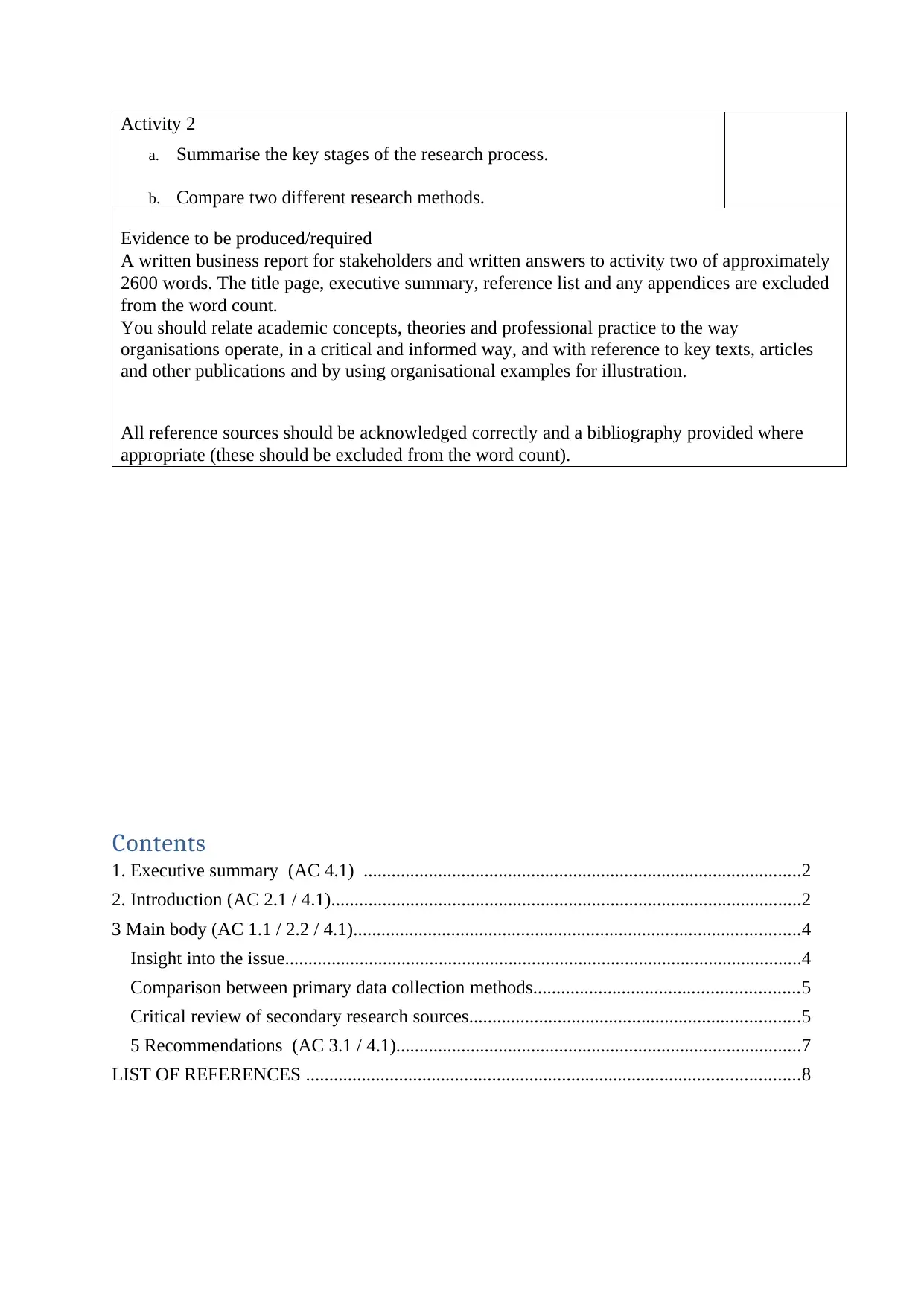
Activity 2
a. Summarise the key stages of the research process.
b. Compare two different research methods.
Evidence to be produced/required
A written business report for stakeholders and written answers to activity two of approximately
2600 words. The title page, executive summary, reference list and any appendices are excluded
from the word count.
You should relate academic concepts, theories and professional practice to the way
organisations operate, in a critical and informed way, and with reference to key texts, articles
and other publications and by using organisational examples for illustration.
All reference sources should be acknowledged correctly and a bibliography provided where
appropriate (these should be excluded from the word count).
Contents
1. Executive summary (AC 4.1) ..............................................................................................2
2. Introduction (AC 2.1 / 4.1).....................................................................................................2
3 Main body (AC 1.1 / 2.2 / 4.1)................................................................................................4
Insight into the issue...............................................................................................................4
Comparison between primary data collection methods.........................................................5
Critical review of secondary research sources.......................................................................5
5 Recommendations (AC 3.1 / 4.1).......................................................................................7
LIST OF REFERENCES ..........................................................................................................8
a. Summarise the key stages of the research process.
b. Compare two different research methods.
Evidence to be produced/required
A written business report for stakeholders and written answers to activity two of approximately
2600 words. The title page, executive summary, reference list and any appendices are excluded
from the word count.
You should relate academic concepts, theories and professional practice to the way
organisations operate, in a critical and informed way, and with reference to key texts, articles
and other publications and by using organisational examples for illustration.
All reference sources should be acknowledged correctly and a bibliography provided where
appropriate (these should be excluded from the word count).
Contents
1. Executive summary (AC 4.1) ..............................................................................................2
2. Introduction (AC 2.1 / 4.1).....................................................................................................2
3 Main body (AC 1.1 / 2.2 / 4.1)................................................................................................4
Insight into the issue...............................................................................................................4
Comparison between primary data collection methods.........................................................5
Critical review of secondary research sources.......................................................................5
5 Recommendations (AC 3.1 / 4.1).......................................................................................7
LIST OF REFERENCES ..........................................................................................................8
Paraphrase This Document
Need a fresh take? Get an instant paraphrase of this document with our AI Paraphraser

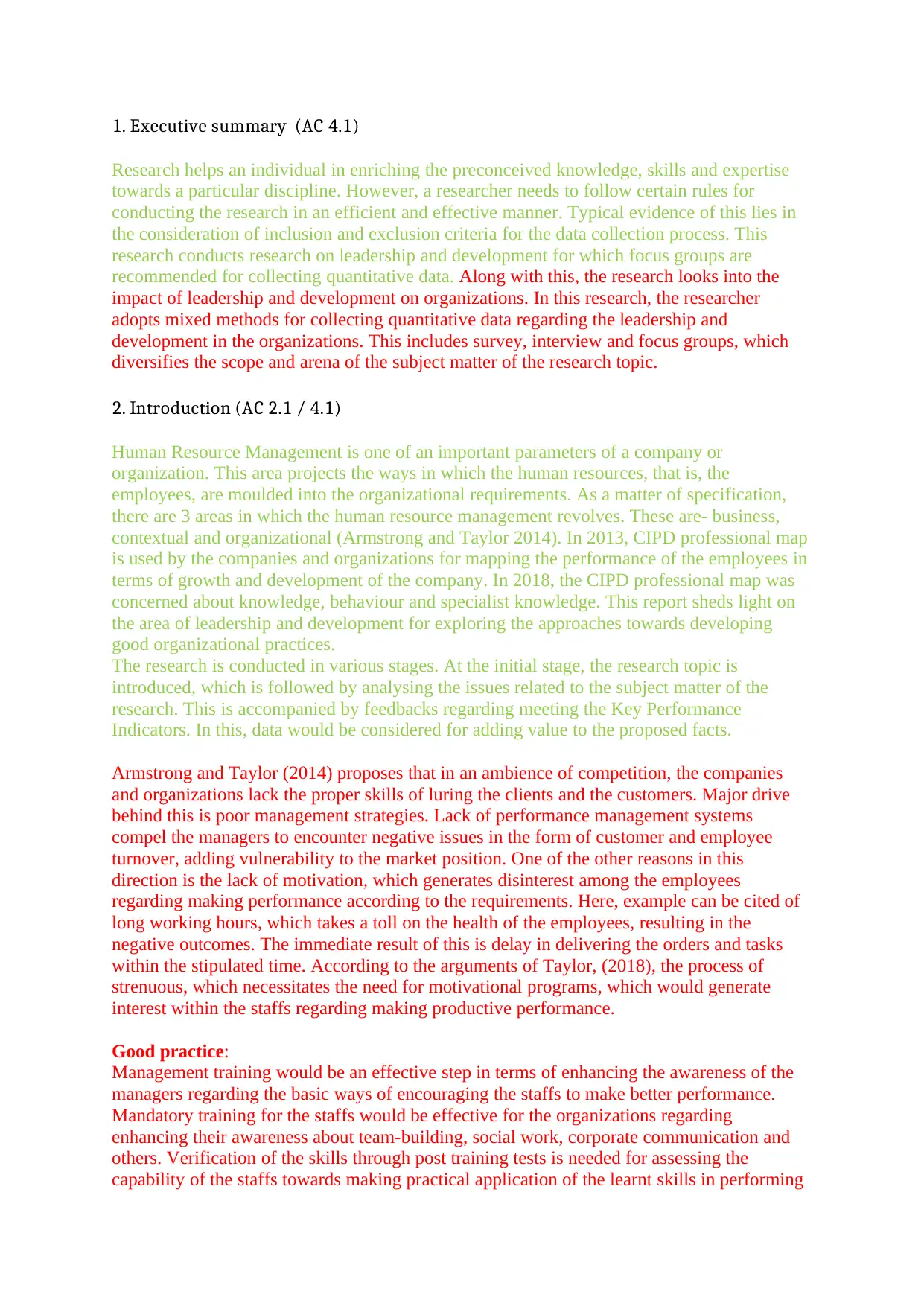
1. Executive summary (AC 4.1)
Research helps an individual in enriching the preconceived knowledge, skills and expertise
towards a particular discipline. However, a researcher needs to follow certain rules for
conducting the research in an efficient and effective manner. Typical evidence of this lies in
the consideration of inclusion and exclusion criteria for the data collection process. This
research conducts research on leadership and development for which focus groups are
recommended for collecting quantitative data. Along with this, the research looks into the
impact of leadership and development on organizations. In this research, the researcher
adopts mixed methods for collecting quantitative data regarding the leadership and
development in the organizations. This includes survey, interview and focus groups, which
diversifies the scope and arena of the subject matter of the research topic.
2. Introduction (AC 2.1 / 4.1)
Human Resource Management is one of an important parameters of a company or
organization. This area projects the ways in which the human resources, that is, the
employees, are moulded into the organizational requirements. As a matter of specification,
there are 3 areas in which the human resource management revolves. These are- business,
contextual and organizational (Armstrong and Taylor 2014). In 2013, CIPD professional map
is used by the companies and organizations for mapping the performance of the employees in
terms of growth and development of the company. In 2018, the CIPD professional map was
concerned about knowledge, behaviour and specialist knowledge. This report sheds light on
the area of leadership and development for exploring the approaches towards developing
good organizational practices.
The research is conducted in various stages. At the initial stage, the research topic is
introduced, which is followed by analysing the issues related to the subject matter of the
research. This is accompanied by feedbacks regarding meeting the Key Performance
Indicators. In this, data would be considered for adding value to the proposed facts.
Armstrong and Taylor (2014) proposes that in an ambience of competition, the companies
and organizations lack the proper skills of luring the clients and the customers. Major drive
behind this is poor management strategies. Lack of performance management systems
compel the managers to encounter negative issues in the form of customer and employee
turnover, adding vulnerability to the market position. One of the other reasons in this
direction is the lack of motivation, which generates disinterest among the employees
regarding making performance according to the requirements. Here, example can be cited of
long working hours, which takes a toll on the health of the employees, resulting in the
negative outcomes. The immediate result of this is delay in delivering the orders and tasks
within the stipulated time. According to the arguments of Taylor, (2018), the process of
strenuous, which necessitates the need for motivational programs, which would generate
interest within the staffs regarding making productive performance.
Good practice:
Management training would be an effective step in terms of enhancing the awareness of the
managers regarding the basic ways of encouraging the staffs to make better performance.
Mandatory training for the staffs would be effective for the organizations regarding
enhancing their awareness about team-building, social work, corporate communication and
others. Verification of the skills through post training tests is needed for assessing the
capability of the staffs towards making practical application of the learnt skills in performing
Research helps an individual in enriching the preconceived knowledge, skills and expertise
towards a particular discipline. However, a researcher needs to follow certain rules for
conducting the research in an efficient and effective manner. Typical evidence of this lies in
the consideration of inclusion and exclusion criteria for the data collection process. This
research conducts research on leadership and development for which focus groups are
recommended for collecting quantitative data. Along with this, the research looks into the
impact of leadership and development on organizations. In this research, the researcher
adopts mixed methods for collecting quantitative data regarding the leadership and
development in the organizations. This includes survey, interview and focus groups, which
diversifies the scope and arena of the subject matter of the research topic.
2. Introduction (AC 2.1 / 4.1)
Human Resource Management is one of an important parameters of a company or
organization. This area projects the ways in which the human resources, that is, the
employees, are moulded into the organizational requirements. As a matter of specification,
there are 3 areas in which the human resource management revolves. These are- business,
contextual and organizational (Armstrong and Taylor 2014). In 2013, CIPD professional map
is used by the companies and organizations for mapping the performance of the employees in
terms of growth and development of the company. In 2018, the CIPD professional map was
concerned about knowledge, behaviour and specialist knowledge. This report sheds light on
the area of leadership and development for exploring the approaches towards developing
good organizational practices.
The research is conducted in various stages. At the initial stage, the research topic is
introduced, which is followed by analysing the issues related to the subject matter of the
research. This is accompanied by feedbacks regarding meeting the Key Performance
Indicators. In this, data would be considered for adding value to the proposed facts.
Armstrong and Taylor (2014) proposes that in an ambience of competition, the companies
and organizations lack the proper skills of luring the clients and the customers. Major drive
behind this is poor management strategies. Lack of performance management systems
compel the managers to encounter negative issues in the form of customer and employee
turnover, adding vulnerability to the market position. One of the other reasons in this
direction is the lack of motivation, which generates disinterest among the employees
regarding making performance according to the requirements. Here, example can be cited of
long working hours, which takes a toll on the health of the employees, resulting in the
negative outcomes. The immediate result of this is delay in delivering the orders and tasks
within the stipulated time. According to the arguments of Taylor, (2018), the process of
strenuous, which necessitates the need for motivational programs, which would generate
interest within the staffs regarding making productive performance.
Good practice:
Management training would be an effective step in terms of enhancing the awareness of the
managers regarding the basic ways of encouraging the staffs to make better performance.
Mandatory training for the staffs would be effective for the organizations regarding
enhancing their awareness about team-building, social work, corporate communication and
others. Verification of the skills through post training tests is needed for assessing the
capability of the staffs towards making practical application of the learnt skills in performing
⊘ This is a preview!⊘
Do you want full access?
Subscribe today to unlock all pages.

Trusted by 1+ million students worldwide
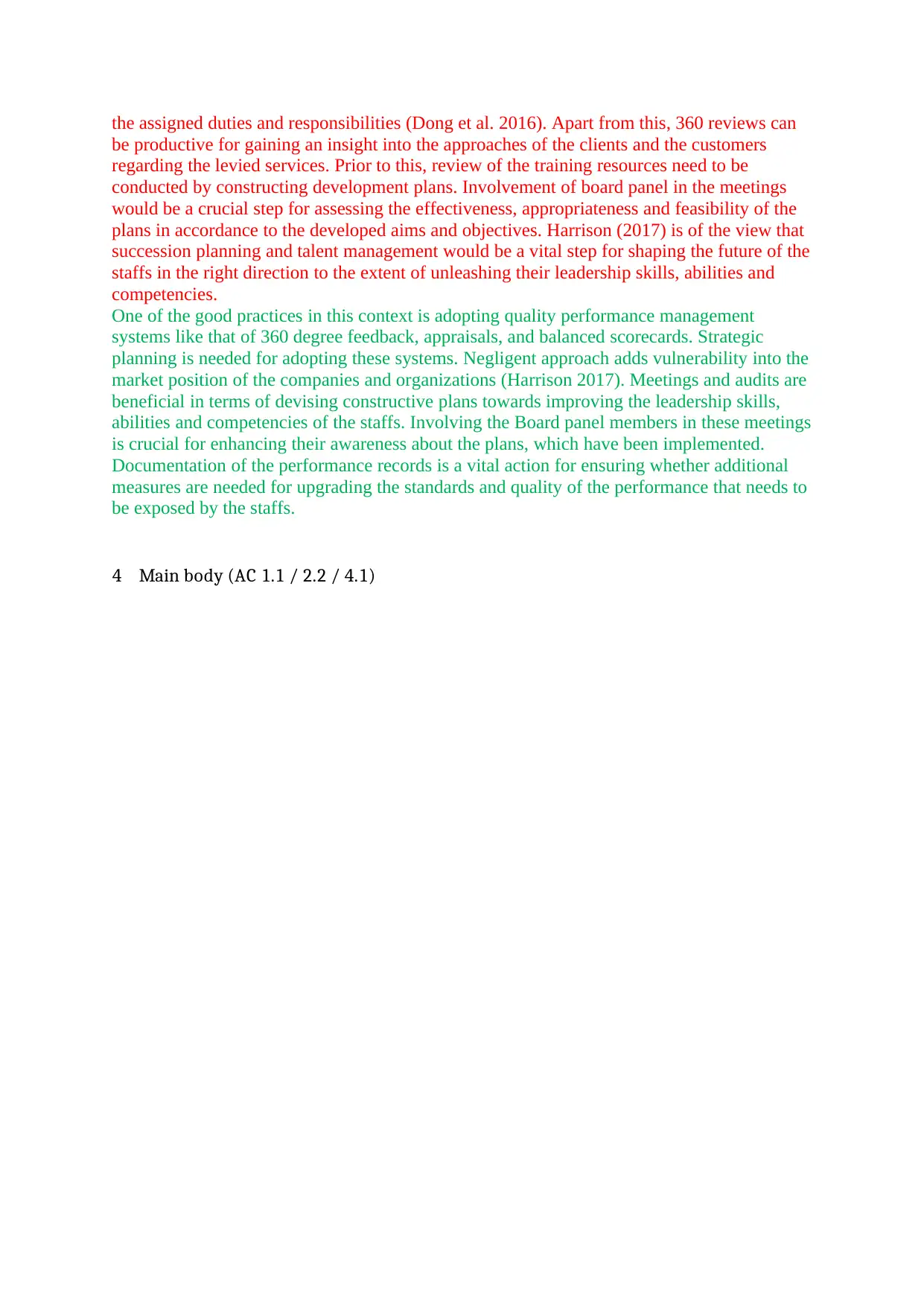
the assigned duties and responsibilities (Dong et al. 2016). Apart from this, 360 reviews can
be productive for gaining an insight into the approaches of the clients and the customers
regarding the levied services. Prior to this, review of the training resources need to be
conducted by constructing development plans. Involvement of board panel in the meetings
would be a crucial step for assessing the effectiveness, appropriateness and feasibility of the
plans in accordance to the developed aims and objectives. Harrison (2017) is of the view that
succession planning and talent management would be a vital step for shaping the future of the
staffs in the right direction to the extent of unleashing their leadership skills, abilities and
competencies.
One of the good practices in this context is adopting quality performance management
systems like that of 360 degree feedback, appraisals, and balanced scorecards. Strategic
planning is needed for adopting these systems. Negligent approach adds vulnerability into the
market position of the companies and organizations (Harrison 2017). Meetings and audits are
beneficial in terms of devising constructive plans towards improving the leadership skills,
abilities and competencies of the staffs. Involving the Board panel members in these meetings
is crucial for enhancing their awareness about the plans, which have been implemented.
Documentation of the performance records is a vital action for ensuring whether additional
measures are needed for upgrading the standards and quality of the performance that needs to
be exposed by the staffs.
4 Main body (AC 1.1 / 2.2 / 4.1)
be productive for gaining an insight into the approaches of the clients and the customers
regarding the levied services. Prior to this, review of the training resources need to be
conducted by constructing development plans. Involvement of board panel in the meetings
would be a crucial step for assessing the effectiveness, appropriateness and feasibility of the
plans in accordance to the developed aims and objectives. Harrison (2017) is of the view that
succession planning and talent management would be a vital step for shaping the future of the
staffs in the right direction to the extent of unleashing their leadership skills, abilities and
competencies.
One of the good practices in this context is adopting quality performance management
systems like that of 360 degree feedback, appraisals, and balanced scorecards. Strategic
planning is needed for adopting these systems. Negligent approach adds vulnerability into the
market position of the companies and organizations (Harrison 2017). Meetings and audits are
beneficial in terms of devising constructive plans towards improving the leadership skills,
abilities and competencies of the staffs. Involving the Board panel members in these meetings
is crucial for enhancing their awareness about the plans, which have been implemented.
Documentation of the performance records is a vital action for ensuring whether additional
measures are needed for upgrading the standards and quality of the performance that needs to
be exposed by the staffs.
4 Main body (AC 1.1 / 2.2 / 4.1)
Paraphrase This Document
Need a fresh take? Get an instant paraphrase of this document with our AI Paraphraser
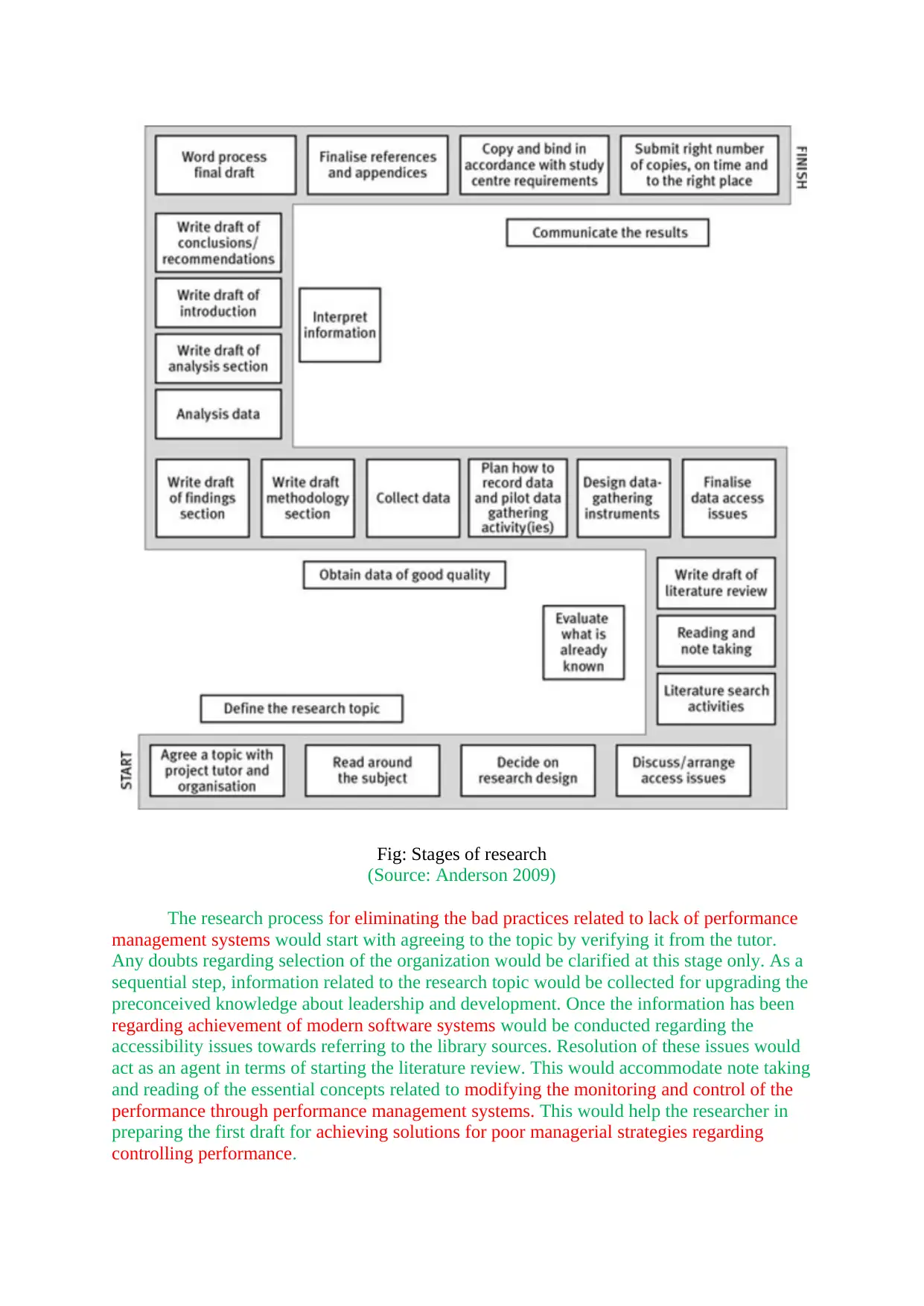
Fig: Stages of research
(Source: Anderson 2009)
The research process for eliminating the bad practices related to lack of performance
management systems would start with agreeing to the topic by verifying it from the tutor.
Any doubts regarding selection of the organization would be clarified at this stage only. As a
sequential step, information related to the research topic would be collected for upgrading the
preconceived knowledge about leadership and development. Once the information has been
regarding achievement of modern software systems would be conducted regarding the
accessibility issues towards referring to the library sources. Resolution of these issues would
act as an agent in terms of starting the literature review. This would accommodate note taking
and reading of the essential concepts related to modifying the monitoring and control of the
performance through performance management systems. This would help the researcher in
preparing the first draft for achieving solutions for poor managerial strategies regarding
controlling performance.
(Source: Anderson 2009)
The research process for eliminating the bad practices related to lack of performance
management systems would start with agreeing to the topic by verifying it from the tutor.
Any doubts regarding selection of the organization would be clarified at this stage only. As a
sequential step, information related to the research topic would be collected for upgrading the
preconceived knowledge about leadership and development. Once the information has been
regarding achievement of modern software systems would be conducted regarding the
accessibility issues towards referring to the library sources. Resolution of these issues would
act as an agent in terms of starting the literature review. This would accommodate note taking
and reading of the essential concepts related to modifying the monitoring and control of the
performance through performance management systems. This would help the researcher in
preparing the first draft for achieving solutions for poor managerial strategies regarding
controlling performance.
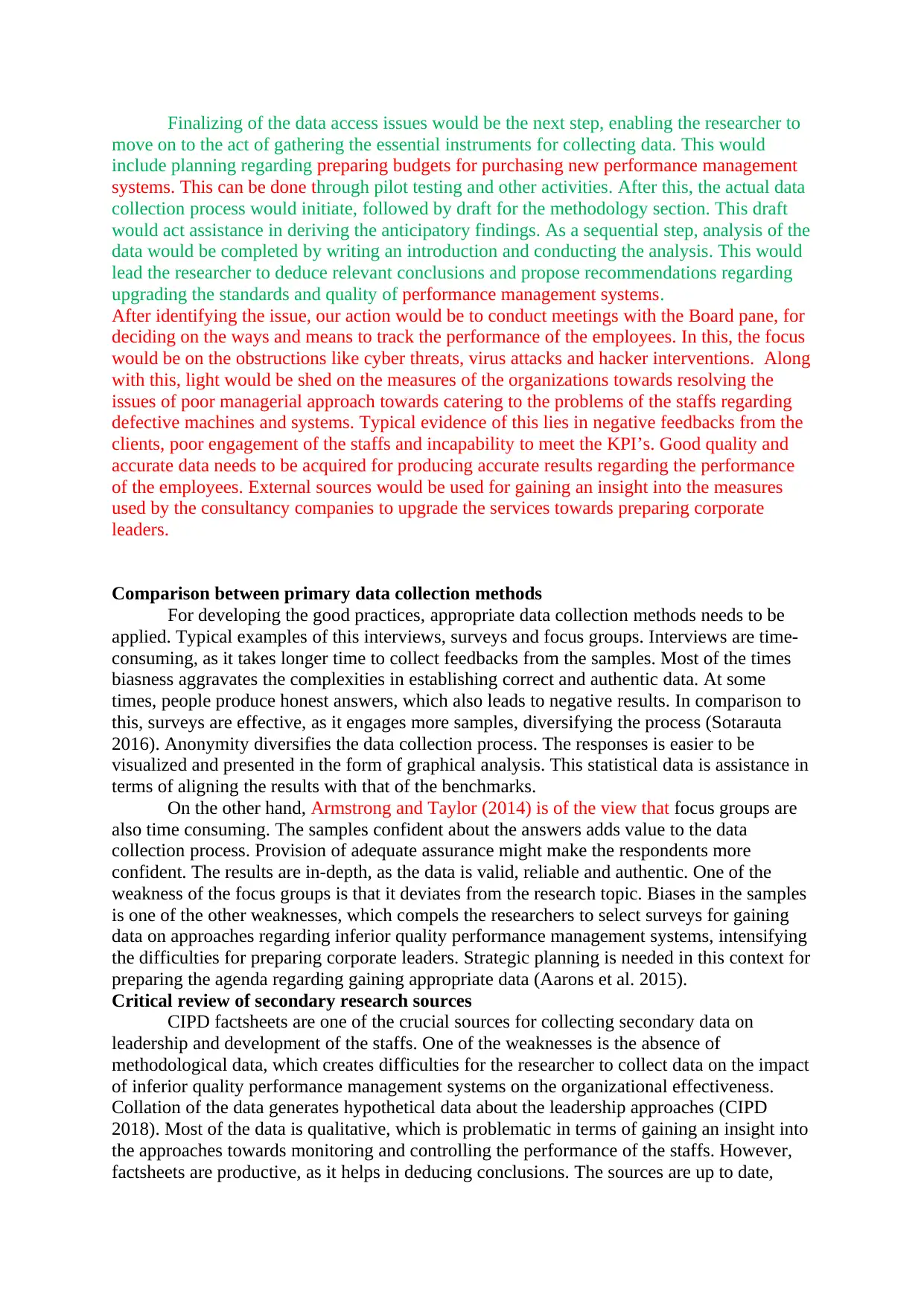
Finalizing of the data access issues would be the next step, enabling the researcher to
move on to the act of gathering the essential instruments for collecting data. This would
include planning regarding preparing budgets for purchasing new performance management
systems. This can be done through pilot testing and other activities. After this, the actual data
collection process would initiate, followed by draft for the methodology section. This draft
would act assistance in deriving the anticipatory findings. As a sequential step, analysis of the
data would be completed by writing an introduction and conducting the analysis. This would
lead the researcher to deduce relevant conclusions and propose recommendations regarding
upgrading the standards and quality of performance management systems.
After identifying the issue, our action would be to conduct meetings with the Board pane, for
deciding on the ways and means to track the performance of the employees. In this, the focus
would be on the obstructions like cyber threats, virus attacks and hacker interventions. Along
with this, light would be shed on the measures of the organizations towards resolving the
issues of poor managerial approach towards catering to the problems of the staffs regarding
defective machines and systems. Typical evidence of this lies in negative feedbacks from the
clients, poor engagement of the staffs and incapability to meet the KPI’s. Good quality and
accurate data needs to be acquired for producing accurate results regarding the performance
of the employees. External sources would be used for gaining an insight into the measures
used by the consultancy companies to upgrade the services towards preparing corporate
leaders.
Comparison between primary data collection methods
For developing the good practices, appropriate data collection methods needs to be
applied. Typical examples of this interviews, surveys and focus groups. Interviews are time-
consuming, as it takes longer time to collect feedbacks from the samples. Most of the times
biasness aggravates the complexities in establishing correct and authentic data. At some
times, people produce honest answers, which also leads to negative results. In comparison to
this, surveys are effective, as it engages more samples, diversifying the process (Sotarauta
2016). Anonymity diversifies the data collection process. The responses is easier to be
visualized and presented in the form of graphical analysis. This statistical data is assistance in
terms of aligning the results with that of the benchmarks.
On the other hand, Armstrong and Taylor (2014) is of the view that focus groups are
also time consuming. The samples confident about the answers adds value to the data
collection process. Provision of adequate assurance might make the respondents more
confident. The results are in-depth, as the data is valid, reliable and authentic. One of the
weakness of the focus groups is that it deviates from the research topic. Biases in the samples
is one of the other weaknesses, which compels the researchers to select surveys for gaining
data on approaches regarding inferior quality performance management systems, intensifying
the difficulties for preparing corporate leaders. Strategic planning is needed in this context for
preparing the agenda regarding gaining appropriate data (Aarons et al. 2015).
Critical review of secondary research sources
CIPD factsheets are one of the crucial sources for collecting secondary data on
leadership and development of the staffs. One of the weaknesses is the absence of
methodological data, which creates difficulties for the researcher to collect data on the impact
of inferior quality performance management systems on the organizational effectiveness.
Collation of the data generates hypothetical data about the leadership approaches (CIPD
2018). Most of the data is qualitative, which is problematic in terms of gaining an insight into
the approaches towards monitoring and controlling the performance of the staffs. However,
factsheets are productive, as it helps in deducing conclusions. The sources are up to date,
move on to the act of gathering the essential instruments for collecting data. This would
include planning regarding preparing budgets for purchasing new performance management
systems. This can be done through pilot testing and other activities. After this, the actual data
collection process would initiate, followed by draft for the methodology section. This draft
would act assistance in deriving the anticipatory findings. As a sequential step, analysis of the
data would be completed by writing an introduction and conducting the analysis. This would
lead the researcher to deduce relevant conclusions and propose recommendations regarding
upgrading the standards and quality of performance management systems.
After identifying the issue, our action would be to conduct meetings with the Board pane, for
deciding on the ways and means to track the performance of the employees. In this, the focus
would be on the obstructions like cyber threats, virus attacks and hacker interventions. Along
with this, light would be shed on the measures of the organizations towards resolving the
issues of poor managerial approach towards catering to the problems of the staffs regarding
defective machines and systems. Typical evidence of this lies in negative feedbacks from the
clients, poor engagement of the staffs and incapability to meet the KPI’s. Good quality and
accurate data needs to be acquired for producing accurate results regarding the performance
of the employees. External sources would be used for gaining an insight into the measures
used by the consultancy companies to upgrade the services towards preparing corporate
leaders.
Comparison between primary data collection methods
For developing the good practices, appropriate data collection methods needs to be
applied. Typical examples of this interviews, surveys and focus groups. Interviews are time-
consuming, as it takes longer time to collect feedbacks from the samples. Most of the times
biasness aggravates the complexities in establishing correct and authentic data. At some
times, people produce honest answers, which also leads to negative results. In comparison to
this, surveys are effective, as it engages more samples, diversifying the process (Sotarauta
2016). Anonymity diversifies the data collection process. The responses is easier to be
visualized and presented in the form of graphical analysis. This statistical data is assistance in
terms of aligning the results with that of the benchmarks.
On the other hand, Armstrong and Taylor (2014) is of the view that focus groups are
also time consuming. The samples confident about the answers adds value to the data
collection process. Provision of adequate assurance might make the respondents more
confident. The results are in-depth, as the data is valid, reliable and authentic. One of the
weakness of the focus groups is that it deviates from the research topic. Biases in the samples
is one of the other weaknesses, which compels the researchers to select surveys for gaining
data on approaches regarding inferior quality performance management systems, intensifying
the difficulties for preparing corporate leaders. Strategic planning is needed in this context for
preparing the agenda regarding gaining appropriate data (Aarons et al. 2015).
Critical review of secondary research sources
CIPD factsheets are one of the crucial sources for collecting secondary data on
leadership and development of the staffs. One of the weaknesses is the absence of
methodological data, which creates difficulties for the researcher to collect data on the impact
of inferior quality performance management systems on the organizational effectiveness.
Collation of the data generates hypothetical data about the leadership approaches (CIPD
2018). Most of the data is qualitative, which is problematic in terms of gaining an insight into
the approaches towards monitoring and controlling the performance of the staffs. However,
factsheets are productive, as it helps in deducing conclusions. The sources are up to date,
⊘ This is a preview!⊘
Do you want full access?
Subscribe today to unlock all pages.

Trusted by 1+ million students worldwide
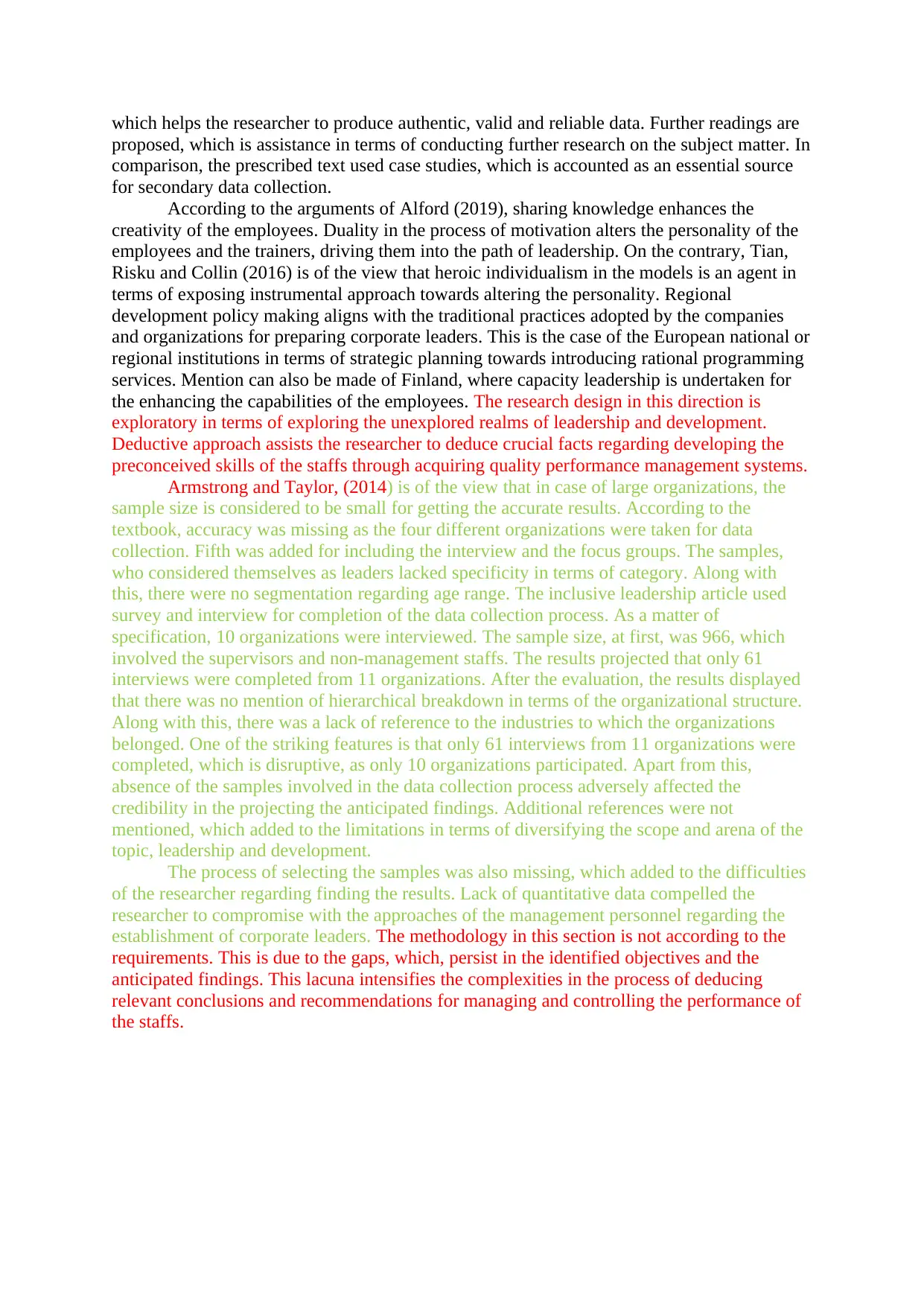
which helps the researcher to produce authentic, valid and reliable data. Further readings are
proposed, which is assistance in terms of conducting further research on the subject matter. In
comparison, the prescribed text used case studies, which is accounted as an essential source
for secondary data collection.
According to the arguments of Alford (2019), sharing knowledge enhances the
creativity of the employees. Duality in the process of motivation alters the personality of the
employees and the trainers, driving them into the path of leadership. On the contrary, Tian,
Risku and Collin (2016) is of the view that heroic individualism in the models is an agent in
terms of exposing instrumental approach towards altering the personality. Regional
development policy making aligns with the traditional practices adopted by the companies
and organizations for preparing corporate leaders. This is the case of the European national or
regional institutions in terms of strategic planning towards introducing rational programming
services. Mention can also be made of Finland, where capacity leadership is undertaken for
the enhancing the capabilities of the employees. The research design in this direction is
exploratory in terms of exploring the unexplored realms of leadership and development.
Deductive approach assists the researcher to deduce crucial facts regarding developing the
preconceived skills of the staffs through acquiring quality performance management systems.
Armstrong and Taylor, (2014) is of the view that in case of large organizations, the
sample size is considered to be small for getting the accurate results. According to the
textbook, accuracy was missing as the four different organizations were taken for data
collection. Fifth was added for including the interview and the focus groups. The samples,
who considered themselves as leaders lacked specificity in terms of category. Along with
this, there were no segmentation regarding age range. The inclusive leadership article used
survey and interview for completion of the data collection process. As a matter of
specification, 10 organizations were interviewed. The sample size, at first, was 966, which
involved the supervisors and non-management staffs. The results projected that only 61
interviews were completed from 11 organizations. After the evaluation, the results displayed
that there was no mention of hierarchical breakdown in terms of the organizational structure.
Along with this, there was a lack of reference to the industries to which the organizations
belonged. One of the striking features is that only 61 interviews from 11 organizations were
completed, which is disruptive, as only 10 organizations participated. Apart from this,
absence of the samples involved in the data collection process adversely affected the
credibility in the projecting the anticipated findings. Additional references were not
mentioned, which added to the limitations in terms of diversifying the scope and arena of the
topic, leadership and development.
The process of selecting the samples was also missing, which added to the difficulties
of the researcher regarding finding the results. Lack of quantitative data compelled the
researcher to compromise with the approaches of the management personnel regarding the
establishment of corporate leaders. The methodology in this section is not according to the
requirements. This is due to the gaps, which, persist in the identified objectives and the
anticipated findings. This lacuna intensifies the complexities in the process of deducing
relevant conclusions and recommendations for managing and controlling the performance of
the staffs.
proposed, which is assistance in terms of conducting further research on the subject matter. In
comparison, the prescribed text used case studies, which is accounted as an essential source
for secondary data collection.
According to the arguments of Alford (2019), sharing knowledge enhances the
creativity of the employees. Duality in the process of motivation alters the personality of the
employees and the trainers, driving them into the path of leadership. On the contrary, Tian,
Risku and Collin (2016) is of the view that heroic individualism in the models is an agent in
terms of exposing instrumental approach towards altering the personality. Regional
development policy making aligns with the traditional practices adopted by the companies
and organizations for preparing corporate leaders. This is the case of the European national or
regional institutions in terms of strategic planning towards introducing rational programming
services. Mention can also be made of Finland, where capacity leadership is undertaken for
the enhancing the capabilities of the employees. The research design in this direction is
exploratory in terms of exploring the unexplored realms of leadership and development.
Deductive approach assists the researcher to deduce crucial facts regarding developing the
preconceived skills of the staffs through acquiring quality performance management systems.
Armstrong and Taylor, (2014) is of the view that in case of large organizations, the
sample size is considered to be small for getting the accurate results. According to the
textbook, accuracy was missing as the four different organizations were taken for data
collection. Fifth was added for including the interview and the focus groups. The samples,
who considered themselves as leaders lacked specificity in terms of category. Along with
this, there were no segmentation regarding age range. The inclusive leadership article used
survey and interview for completion of the data collection process. As a matter of
specification, 10 organizations were interviewed. The sample size, at first, was 966, which
involved the supervisors and non-management staffs. The results projected that only 61
interviews were completed from 11 organizations. After the evaluation, the results displayed
that there was no mention of hierarchical breakdown in terms of the organizational structure.
Along with this, there was a lack of reference to the industries to which the organizations
belonged. One of the striking features is that only 61 interviews from 11 organizations were
completed, which is disruptive, as only 10 organizations participated. Apart from this,
absence of the samples involved in the data collection process adversely affected the
credibility in the projecting the anticipated findings. Additional references were not
mentioned, which added to the limitations in terms of diversifying the scope and arena of the
topic, leadership and development.
The process of selecting the samples was also missing, which added to the difficulties
of the researcher regarding finding the results. Lack of quantitative data compelled the
researcher to compromise with the approaches of the management personnel regarding the
establishment of corporate leaders. The methodology in this section is not according to the
requirements. This is due to the gaps, which, persist in the identified objectives and the
anticipated findings. This lacuna intensifies the complexities in the process of deducing
relevant conclusions and recommendations for managing and controlling the performance of
the staffs.
Paraphrase This Document
Need a fresh take? Get an instant paraphrase of this document with our AI Paraphraser
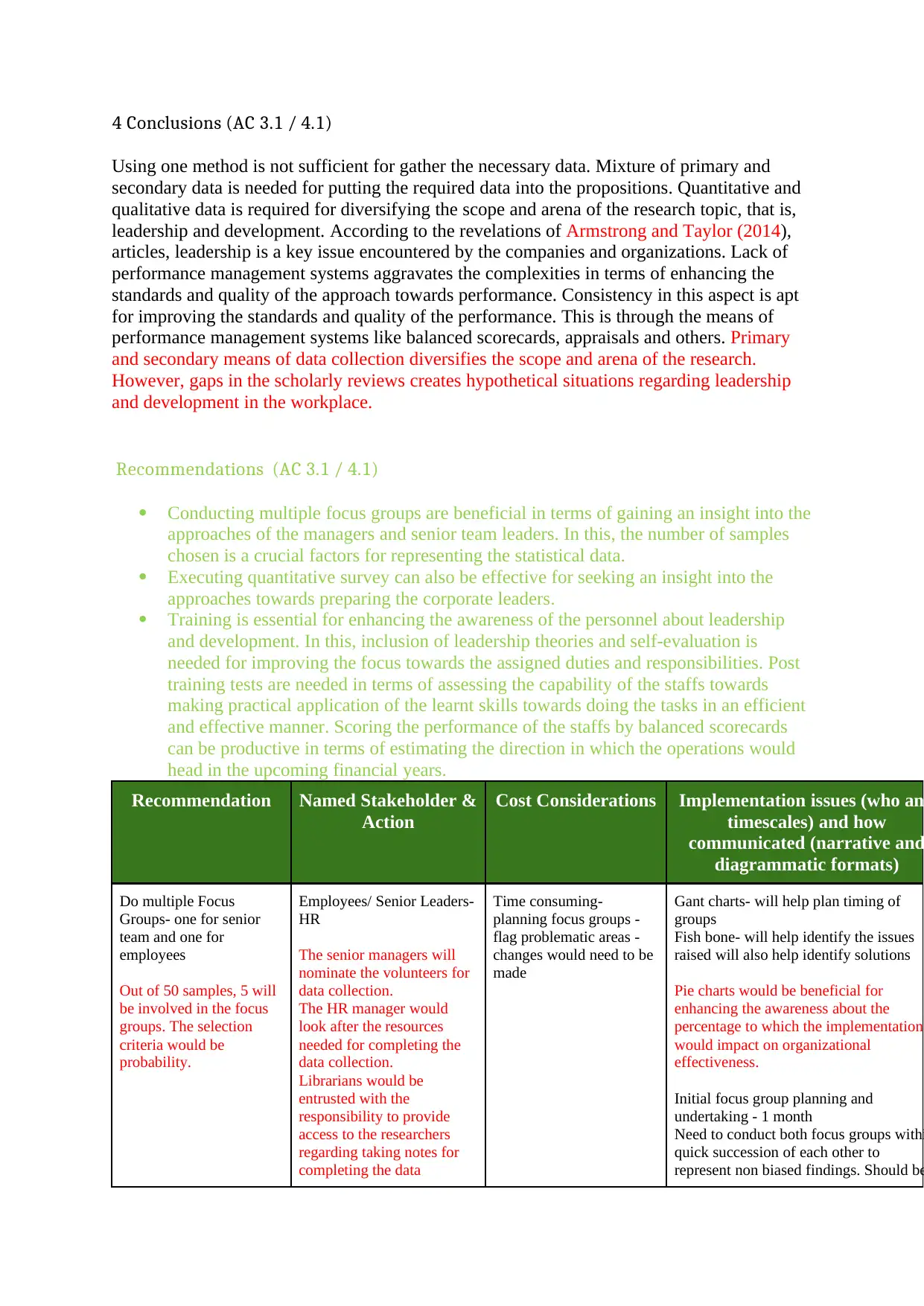
4 Conclusions (AC 3.1 / 4.1)
Using one method is not sufficient for gather the necessary data. Mixture of primary and
secondary data is needed for putting the required data into the propositions. Quantitative and
qualitative data is required for diversifying the scope and arena of the research topic, that is,
leadership and development. According to the revelations of Armstrong and Taylor (2014),
articles, leadership is a key issue encountered by the companies and organizations. Lack of
performance management systems aggravates the complexities in terms of enhancing the
standards and quality of the approach towards performance. Consistency in this aspect is apt
for improving the standards and quality of the performance. This is through the means of
performance management systems like balanced scorecards, appraisals and others. Primary
and secondary means of data collection diversifies the scope and arena of the research.
However, gaps in the scholarly reviews creates hypothetical situations regarding leadership
and development in the workplace.
Recommendations (AC 3.1 / 4.1)
Conducting multiple focus groups are beneficial in terms of gaining an insight into the
approaches of the managers and senior team leaders. In this, the number of samples
chosen is a crucial factors for representing the statistical data.
Executing quantitative survey can also be effective for seeking an insight into the
approaches towards preparing the corporate leaders.
Training is essential for enhancing the awareness of the personnel about leadership
and development. In this, inclusion of leadership theories and self-evaluation is
needed for improving the focus towards the assigned duties and responsibilities. Post
training tests are needed in terms of assessing the capability of the staffs towards
making practical application of the learnt skills towards doing the tasks in an efficient
and effective manner. Scoring the performance of the staffs by balanced scorecards
can be productive in terms of estimating the direction in which the operations would
head in the upcoming financial years.
Recommendation Named Stakeholder &
Action
Cost Considerations Implementation issues (who an
timescales) and how
communicated (narrative and
diagrammatic formats)
Do multiple Focus
Groups- one for senior
team and one for
employees
Out of 50 samples, 5 will
be involved in the focus
groups. The selection
criteria would be
probability.
Employees/ Senior Leaders-
HR
The senior managers will
nominate the volunteers for
data collection.
The HR manager would
look after the resources
needed for completing the
data collection.
Librarians would be
entrusted with the
responsibility to provide
access to the researchers
regarding taking notes for
completing the data
Time consuming-
planning focus groups -
flag problematic areas -
changes would need to be
made
Gant charts- will help plan timing of
groups
Fish bone- will help identify the issues
raised will also help identify solutions
Pie charts would be beneficial for
enhancing the awareness about the
percentage to which the implementation
would impact on organizational
effectiveness.
Initial focus group planning and
undertaking - 1 month
Need to conduct both focus groups withi
quick succession of each other to
represent non biased findings. Should be
Using one method is not sufficient for gather the necessary data. Mixture of primary and
secondary data is needed for putting the required data into the propositions. Quantitative and
qualitative data is required for diversifying the scope and arena of the research topic, that is,
leadership and development. According to the revelations of Armstrong and Taylor (2014),
articles, leadership is a key issue encountered by the companies and organizations. Lack of
performance management systems aggravates the complexities in terms of enhancing the
standards and quality of the approach towards performance. Consistency in this aspect is apt
for improving the standards and quality of the performance. This is through the means of
performance management systems like balanced scorecards, appraisals and others. Primary
and secondary means of data collection diversifies the scope and arena of the research.
However, gaps in the scholarly reviews creates hypothetical situations regarding leadership
and development in the workplace.
Recommendations (AC 3.1 / 4.1)
Conducting multiple focus groups are beneficial in terms of gaining an insight into the
approaches of the managers and senior team leaders. In this, the number of samples
chosen is a crucial factors for representing the statistical data.
Executing quantitative survey can also be effective for seeking an insight into the
approaches towards preparing the corporate leaders.
Training is essential for enhancing the awareness of the personnel about leadership
and development. In this, inclusion of leadership theories and self-evaluation is
needed for improving the focus towards the assigned duties and responsibilities. Post
training tests are needed in terms of assessing the capability of the staffs towards
making practical application of the learnt skills towards doing the tasks in an efficient
and effective manner. Scoring the performance of the staffs by balanced scorecards
can be productive in terms of estimating the direction in which the operations would
head in the upcoming financial years.
Recommendation Named Stakeholder &
Action
Cost Considerations Implementation issues (who an
timescales) and how
communicated (narrative and
diagrammatic formats)
Do multiple Focus
Groups- one for senior
team and one for
employees
Out of 50 samples, 5 will
be involved in the focus
groups. The selection
criteria would be
probability.
Employees/ Senior Leaders-
HR
The senior managers will
nominate the volunteers for
data collection.
The HR manager would
look after the resources
needed for completing the
data collection.
Librarians would be
entrusted with the
responsibility to provide
access to the researchers
regarding taking notes for
completing the data
Time consuming-
planning focus groups -
flag problematic areas -
changes would need to be
made
Gant charts- will help plan timing of
groups
Fish bone- will help identify the issues
raised will also help identify solutions
Pie charts would be beneficial for
enhancing the awareness about the
percentage to which the implementation
would impact on organizational
effectiveness.
Initial focus group planning and
undertaking - 1 month
Need to conduct both focus groups withi
quick succession of each other to
represent non biased findings. Should be
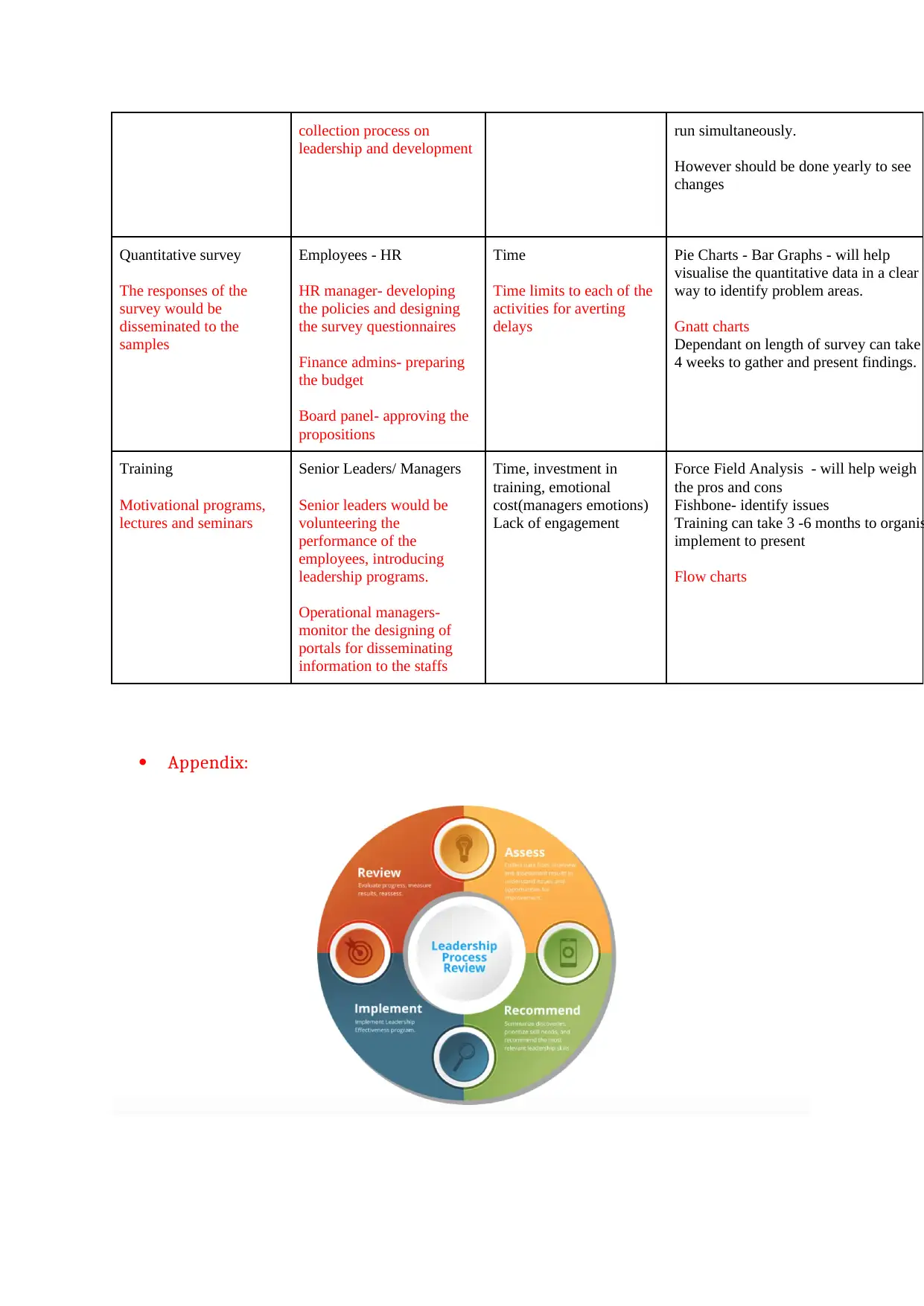
collection process on
leadership and development
run simultaneously.
However should be done yearly to see
changes
Quantitative survey
The responses of the
survey would be
disseminated to the
samples
Employees - HR
HR manager- developing
the policies and designing
the survey questionnaires
Finance admins- preparing
the budget
Board panel- approving the
propositions
Time
Time limits to each of the
activities for averting
delays
Pie Charts - Bar Graphs - will help
visualise the quantitative data in a clear
way to identify problem areas.
Gnatt charts
Dependant on length of survey can take
4 weeks to gather and present findings.
Training
Motivational programs,
lectures and seminars
Senior Leaders/ Managers
Senior leaders would be
volunteering the
performance of the
employees, introducing
leadership programs.
Operational managers-
monitor the designing of
portals for disseminating
information to the staffs
Time, investment in
training, emotional
cost(managers emotions)
Lack of engagement
Force Field Analysis - will help weigh
the pros and cons
Fishbone- identify issues
Training can take 3 -6 months to organis
implement to present
Flow charts
Appendix:
leadership and development
run simultaneously.
However should be done yearly to see
changes
Quantitative survey
The responses of the
survey would be
disseminated to the
samples
Employees - HR
HR manager- developing
the policies and designing
the survey questionnaires
Finance admins- preparing
the budget
Board panel- approving the
propositions
Time
Time limits to each of the
activities for averting
delays
Pie Charts - Bar Graphs - will help
visualise the quantitative data in a clear
way to identify problem areas.
Gnatt charts
Dependant on length of survey can take
4 weeks to gather and present findings.
Training
Motivational programs,
lectures and seminars
Senior Leaders/ Managers
Senior leaders would be
volunteering the
performance of the
employees, introducing
leadership programs.
Operational managers-
monitor the designing of
portals for disseminating
information to the staffs
Time, investment in
training, emotional
cost(managers emotions)
Lack of engagement
Force Field Analysis - will help weigh
the pros and cons
Fishbone- identify issues
Training can take 3 -6 months to organis
implement to present
Flow charts
Appendix:
⊘ This is a preview!⊘
Do you want full access?
Subscribe today to unlock all pages.

Trusted by 1+ million students worldwide
1 out of 16
Related Documents
Your All-in-One AI-Powered Toolkit for Academic Success.
+13062052269
info@desklib.com
Available 24*7 on WhatsApp / Email
![[object Object]](/_next/static/media/star-bottom.7253800d.svg)
Unlock your academic potential
Copyright © 2020–2025 A2Z Services. All Rights Reserved. Developed and managed by ZUCOL.





